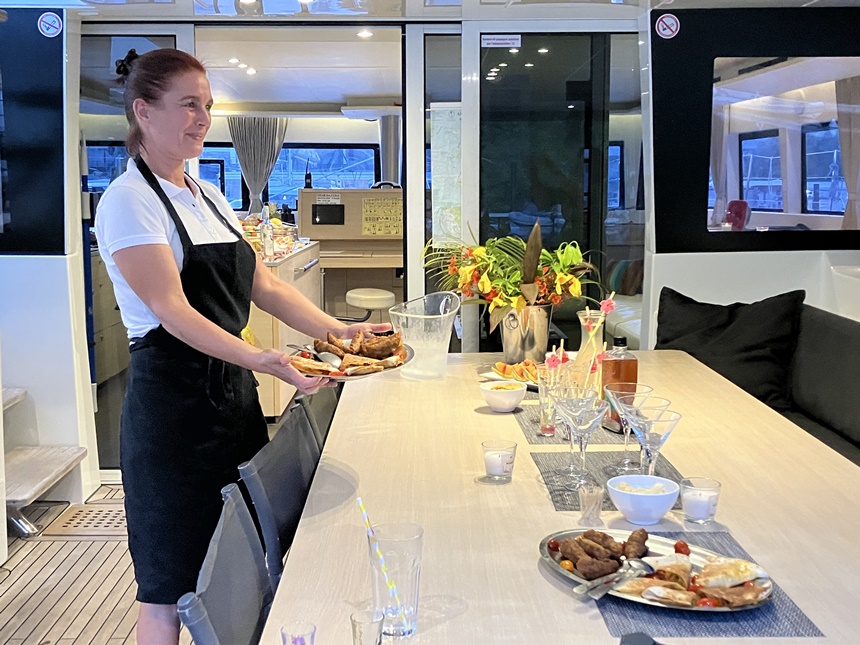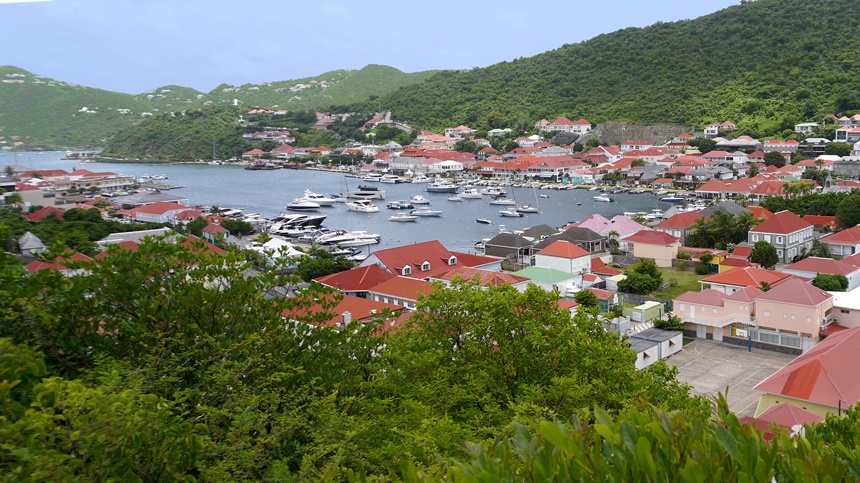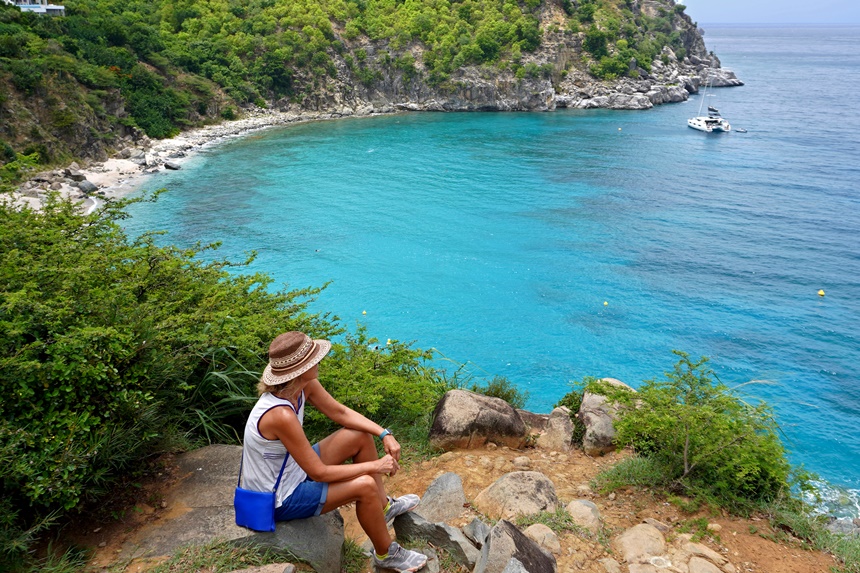I am splayed in an oversized bean bag on the top deck of the 62-foot catamaran Dream Baliceaux, watching a torrent of stars spill behind the five peaks of a Caribbean island called Île Fourchue.
Off in the darkness, the chihuahua-like barks of nesting brown boobies float on the still tropical air from nearby Petite Islette.
As the boat softly rises and falls, its twin hulls slapped softly by the rippled waters of this protected bay, I spot near the horizon the profile of an enormous cruise ship. Most likely, it’s one of those seagoing behemoths with four-story water slides and on-board surfing and conga lines and more people than a small city, setting course for a teeming tourist destination where straw hats and plaster coconut trees line the shop shelves and dockside hucksters wave Happy Hour flyers like they’re the national flag.
I sigh. “Those poor wretches,” I mutter.
Here’s a hypothetical question for you:
Would you rather book a four-night, 3,000-passenger Bahamas cruise with an inside cabin and a TV screen for a porthole — or, for about the same amount of money, embark on a seven-night Caribbean voyage aboard a catamaran yacht with eight fellow travelers, all meals locally sourced by a private chef and every night spent bobbing in a secluded bay under the Milky Way?
Yeah, I know. I kinda loaded the second half of that question. But that’s the not-so-daunting dilemma I faced this past summer, weighing my options as I planned a tropical trip for two.
When most people think about yacht charters, they imagine being handed the keys to a private boat and told, “You’re on your own. See you in a week. Don’t scratch the paint.” But an increasing number of travel companies are offering fully crewed private yacht trips on set itineraries; trips that offer all the romance of a high seas adventure while requiring little more than the ability to pack some t-shirts and a couple of spare bathing suits.
Most importantly, such trips are remarkably affordable. If you can gather together enough friends and loved ones to fill five or six double cabins, companies like Boats at Sea and Virgin Island Sailing will send you off in the Caribbean with a captain and chef for prices starting between $1,500 and $3,000 per person, including just about everything. Prices can vary by destination, but even in the Mediterranean and South Pacific, private yachting gives ocean liners a run for their money.
For this trip, I’ve opted for a booking on Dream Yacht sailing vacations, which doesn’t require you to fill out the passenger list on your own: For a cabin that starts at about $1,300 per person (even less for last-minute fares), I’ve booked a week-long cruise for two out of St. Martin in the Leeward Islands, and the company has filled the rest of the cabins with similarly adventurous travelers.
Of course, “adventure” is in the eye of the beholder: The air-conditioned cabins on this boat have queen beds with private baths and showers. Because the cabins are located in the twin pontoons of the catamaran, your window is right above water level, which gives you a pretty cool view of the passing sea. But you’ll want to spend most of your travel days up top, feeling the breeze and watching the gulls swoop in and out of the catamaran’s draft.
If you feel the urge to get moving, you can always launch yourself in the boat’s tandem kayak or paddleboard, or dive off the back using the provided snorkel gear.
Breakfast, lunch, dinner, and snacks are all prepared by a chef, and the cost includes a cocktail each evening (if you want more alcohol on the trip, you can arrange that ahead of time).

And you don’t have to wait your turn to disembark.
It is a 25-minute ride from the brand-new Princess Juliana International Airport on the island of Sint Maarten (“The Dutch Side”) to Grande Case, St. Martin (“The French Side” of the same island), the location of the private harbor where Dream Yacht has its Leeward Islands base.
Dream Baliceaux, typical of the catamarans used on these trips, is a Lagoon 620-style cat, a 62-foot-long craft that sleeps 12 in six staterooms (plus crew quarters). The cabins are roughly the same size as you’ll find on much bigger ships, and there’s plenty of elbow room above deck, in the couch-lined, air-conditioned “saloon” (which also contains the boat’s enormous kitchen, realm of the full-time chef). Toward the back of the main deck is a covered dining area with a long table and stairs leading down to the water.

Up top is the flybridge, where the captain navigates and the rest of us lounge on cushioned benches and, in a shallow well up front, those bean bag chairs, keeping an eye out for dolphins and flying fish.
Our Skipper, David, welcomes us aboard. A native of the French maritime city of La Rochelle, he’s been a sailor all his life, as evidenced in his permanent tan and the way he scrambles from deck to deck along the ship’s exterior, not bothering with inconveniences like stairs and ladders.
Our chef is Nathalie, not a lifelong seafaring woman, but one with a miraculous way of crafting gourmet meals from whatever happens to be available in our ports of call. Whether she’s placing before us a steaming plate of ratatouille, curried chicken, mussels in wine sauce, Greek phyllo meat pie or, astonishingly, 15 different kinds of pizza (and desserts like chocolate brownies with vanilla sauce and pineapple upside-down cake), halfway through the trip I begin to suspect there are DoorDash dinghies pulling up amidship with deliveries each day.
By our second day on the catamaran, the rhythms of shipboard life have already begun to take shape: The sun filtering through our drawn shades leads to a slow-motion, yawning emergence from our cabin. Breakfast is already being made, and the low morning sunlight is angling off the water of our protected cove and into the dining area.
When we’re good and ready, we either dip into the warm, turquoise water off the back deck or accept a lift ashore from David, piloting a small inflatable boat. It is summer, off-season in the Caribbean, so we pretty much have the bays and the beaches to ourselves.

By late morning we’re back on board for lunch, after which Nathalie throws some bread off the back of the boat. Almost immediately, it is being devoured by a fish I immediately identify as a shark.
“That’s not a shark,” David corrects me. “That’s a remora.”
He’s right, of course, and I feel humbled; a city boy trying to identify wildlife.
“We do get sharks,” he adds. “If we throw chicken overboard. Then it’s….”
He starts waving his arms, snarling and gnashing his teeth.
“Like that,” he says. I wish I could witness it in person, but David’s reenactment is almost as good.
David revs up the cat’s engines, setting course for our next island destination. From St. Martin we plow east through whitecapped seas to a low-lying sand spit called Île Tintamarre, also known as Flat Island.
From a 1,000-foot-long cruise ship, spots like this are little more than blips on the bridge radar, largely interchangeable and easily ignored. From catamaran level, though, each Caribbean island becomes a realm unto itself. Île Tintamarre is an arc of sand interrupted by occasional deposits of rock and coral (the remnants of an old quarry lay inland). It’s a classic desert island, anything but deserted: Sit still long enough and you’ll glimpse hummingbirds flitting by from one tropical flowering tree to the next, and over the water you’ll spot sleek red-billed tropicbirds — their long, slender tails causing them to resemble kites as much as critters — diving for squid.
Here, time is measured more by the position of the sun than by smart watches. As dusk approaches, Nathalie summons us to the long table for the dinner she has prepared while we were playing. The sky turns purple, then gray, then black, a galaxy of stars winking to life. Across the bay, white lights perched atop the masts of the four or five other catamarans near us sway to and fro, resembling shooting stars that never burn out.
The up-close progression of unexpectedly varied islands continues through the week. Pushing south, what first appears to be a succession of five peaked islands turns out to be one continuous 300-foot-high range on a single sickle-shaped landmass — Île Fourchue. From the island’s beach, we pick out a narrow, stony path that leads to a saddle between two of the highest summits, the cactus-lined route guarded by enormous iguanas, positioned on rocky outcrops like scaled gargoyles.

We find a bench-like rock and face the setting sun. A half-mile or so away, a troupe of teenagers — residents of a nearby tropical sleepaway camp — have scaled the island’s highest peak and are perched on top; chattering ants on a sugarloaf.
From where we are sitting, the sun is setting out of sight, behind that sugarloaf of a mountain. But we’re not planning to linger, anyway — because the tropical sun plunges straight down into the sea, the period between dusk and darkness is notoriously short. We’d best head back down to the beach before the night hides our path completely.
But as we go, one last look: The rugged landscape plunging into a purple sea; scattered piles of clouds echoing the thrusting pillars of island rock. And swaying calmly in the bay, Dream Baliceaux, our floating home, patiently waiting.

Our southernmost stop is the large island of Saint Barthélemy, more widely known as St. Bart’s — named rather presumptuously by Christoper Columbus for his younger brother.
Our first overnight stop there is Colombier Beach, on the island’s north side. The place seems remote and untouched, except for an intriguingly incongruent, low-slung stone structure on a bluff overlooking the beach.
“The Rockefellers built that,” says David. “But now it’s a ruin.”
It was David Rockefeller, grandson of John D., who, along with his wife, Peggy, built the place in the late 1950s. It was a marvel of architecture at the time, with separate living and dining rooms linked by stone pathways and punctuated by flowing water and banana trees.
Hurricanes reduced the place to ruin, but a commodities broker recently bought it for $136 million.
“I guess they’ll fix it up,” says David with a shrug. “We’ll see.”
I nod in agreement. The Caribbean is littered with grandiose plans that fell victim to the realities of economics and tropical storms.
The one major town of our trip is Gustavia, on the west side of St. Bart’s. As we cruise into port, we find a handful of yachts in the harbor. “In January,” says David, waving his hand as arrive, “there are hundreds of boats here.”

Indeed, St. Barts in season is a tropical red carpet, walked regularly by the likes of Beyoncé, Gwen Stefani, Jon Bon Jovi, Jeff Bezos, Jason Statham, and Orlando Bloom. But today, in midsummer, Gustavia is all ours: We browse the shops, eat at an open café, sit in a cool pew at St. Bartholomew’s Anglican Church (1855), and climb a steep stairway to Fort Karl, built by the Swedes when all of Europe seemed to consider the Caribbean its branch office.
From St. Martin to this point, we’ve been making short island hops, never sailing more than an hour or so each day, and always under motor power, due to the prevailing wind direction. But now it’s time to return to our home port. That will involve a healthy 20-mile sprint across open sea.
And for the first time on our journey, David hoists Dream Baliceaux’s sails.
Like a large dog pulling at its leash, the southerly wind tugs at Dream Baliceaux, sending us northward in a lurch. The sails, previously wound tightly at the base of their masts, billow exultantly, as if released from a shroud.
I sit on the flybridge, half-watching David at the wheel, shamelessly enthralled in the age-old arts of the sea; half-mesmerized by the sheer force of nature catapulting us forward, feeling an ageless kinship to the pioneering sailors of Mesopotamia and, yes, those self-styled European hero/explorers, expanding the margins of their monarchs, wreaking cultural havoc while fancying themselves doing God’s work.
If I had any hair left, it would be flying in that salty Caribbean air. In the corner of one eye, do I catch a glimpse of a cruise ship, steaming to its next “Duty Free Rum Sale” port?
We are leaving it in our wake.
IF YOU GO: As with most cruises, you’ll need to arrange your own flights to the airport closest to the ship (most companies will arrange ground transportation for additional cost). Tips, local destination fees, and most alcoholic drinks are extra.
Travelers should note that, because yacht plumbing is delicate and the nearest plumber can sometimes be miles away by boat, absolutely no tissue can be flushed in the onboard restrooms. This means, yes, absolutely no tissue — which must instead be placed in bathroom trash cans the crew empties each day. Sounds dicey but, trust me, you somehow get used to it almost immediately.
Become a Saturday Evening Post member and enjoy unlimited access. Subscribe now



